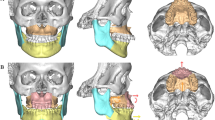Abstract
Objectives
Maxillomandibular advancement (MMA) confers consistent and high rates of surgical success for obstructive sleep apnea (OSA). In the era of value-based medicine, identifying factors that affect the stability of rigid fixation and allow rapid return to function are important targets for improvement. The aim of this study was to identify patient and surgical factors associated with mandibular sagittal split outcomes associated with optimal postoperatively skeletal stability.
Study design
Retrospective cohort study.
Materials and methods
Forty-six subjects (43 males and 3 females) with postoperative CT scans including three-dimensional reconstruction from which mandibular split patterns could be analyzed were enrolled. Patient factors (age and polysomnographic measures) and surgical factors (extent of osteotomy prior to controlled fracture) were assessed. Outcome measures include (1) bone thickness for rigid fixation and (2) area of passive bony overlap after advancement.
Results
Age and severity of disease did not contribute significantly to optimal mandibular split patterns. For optimal area for passive bony overlap and thickness of buccal and lingual plates for rigid fixation, the most important factors are related to surgical technique.
Conclusions
Anterior osteotomy just to the midline of inferior border and horizontal osteotomy to the mandibular foramen are associated with split patterns that result in optimal rigid fixation and passive bony overlap for OSA patients undergoing MMA.
Clinical relevance
Optimal surgical technique has the most significant influence in allowing rapid return to function after MMA in patients with OSA.




Similar content being viewed by others
References
Holty JE, Guilleminault C (2010) Maxillomandibular advancement for the treatment of obstructive sleep apnea: a systematic review and meta-analysis. Sleep Med Rev 14(5):287–297
Zaghi S, Holty JEC, Certal V, Abdullatif J, Guilleminault C, Powell NB, Riley RW, Camacho M (2016) Maxillomandibular advancement for treatment of obstructive sleep apnea: a meta-analysis. JAMA Otolaryngol Head Neck Surg 142(1):58–66
Liu SY et al (2016) Efficacy of maxillomandibular advancement examined with drug-induced sleep endoscopy and computational fluid dynamics airflow modeling. Otolaryngol Head Neck Surg 154(1):189–195
Liu SY et al (2015) Lateral pharyngeal wall tension after maxillomandibular advancement for obstructive sleep apnea is a marker for surgical success: observations from drug-induced sleep endoscopy. J Oral Maxillofac Surg 73(8):1575–1582
Ljungqvist O, Scott M, Fearon KC (2017) Enhanced recovery after surgery: a review. JAMA Surg 152(3):292–298
Weeks WB, Schoellkopf WJ, Sorensen LS, Masica AL, Nesse RE, Weinstein JN (2017) The high value healthcare collaborative: observational analyses of care episodes for hip and knee arthroplasty surgery. J Arthroplast 32(3):702–708
Arnardottir ES, Mackiewicz M, Gislason T, Teff KL, Pack AI (2009) Molecular signatures of obstructive sleep apnea in adults: a review and perspective. Sleep 32(4):447–470
Verweij JP, Mensink G, Houppermans PNWJ, van Merkesteyn JPR (2015) Angled osteotomy design aimed to influence the lingual fracture line in bilateral sagittal split osteotomy: a human cadaveric study. J Oral Maxillofac Surg 73(10):1983–1993
Hamada S, Ikezoe K, Hirai T, Oguma T, Tanizawa K, Inouchi M, Handa T, Oga T, Mishima M, Chin K (2016) Evaluation of bone mineral density by computed tomography in patients with obstructive sleep apnea. J Clin Sleep Med 12(1):25–34
Arnett TR, Gibbons DC, Utting JC, Orriss IR, Hoebertz A, Rosendaal M, Meghji S (2003) Hypoxia is a major stimulator of osteoclast formation and bone resorption. J Cell Physiol 196(1):2–8
Kriwalsky MS, Maurer P, Veras RB, Eckert AW, Schubert J (2008) Risk factors for a bad split during sagittal split osteotomy. Br J Oral Maxillofac Surg 46(3):177–179
Camacho M, Liu SY, Certal V, Capasso R, Powell NB, Riley RW (2015) Large maxillomandibular advancements for obstructive sleep apnea: an operative technique evolved over 30 years. J Craniomaxillofac Surg 43(7):1113–1118
Plooij JM, Naphausen MTP, Maal TJJ, Xi T, Rangel FA, Swennnen G, de Koning M, Borstlap WA, Bergé SJ (2009) 3D evaluation of the lingual fracture line after a bilateral sagittal split osteotomy of the mandible. Int J Oral Maxillofac Surg 38(12):1244–1249
Wolford LM, Bennett MA, Rafferty CG (1987) Modification of the mandibular ramus sagittal split osteotomy. Oral Surg Oral Med Oral Pathol 64(2):146–155
Aarabi M, Tabrizi R, Hekmat M, Shahidi S, Puzesh A (2014) Relationship between mandibular anatomy and the occurrence of a bad split upon sagittal split osteotomy. J Oral Maxillofac Surg 72(12):2508–2513
Author information
Authors and Affiliations
Corresponding author
Ethics declarations
Conflict of interest
The authors declare that they have no conflict of interest.
Ethical approval
This article does not contain any studies with human participants or animals performed by any of the authors.
Informed consent
For this type of study, formal consent is not required.
Additional information
Publisher’s note
Springer Nature remains neutral with regard to jurisdictional claims in published maps and institutional affiliations.
Rights and permissions
About this article
Cite this article
Chen, Y.F., Ko, E.C., Zaghi, S. et al. Optimizing mandibular sagittal split of large maxillomandibular advancements for obstructive sleep apnea: patient and surgical factors. Clin Oral Invest 24, 1359–1367 (2020). https://doi.org/10.1007/s00784-019-03017-5
Received:
Accepted:
Published:
Issue Date:
DOI: https://doi.org/10.1007/s00784-019-03017-5



